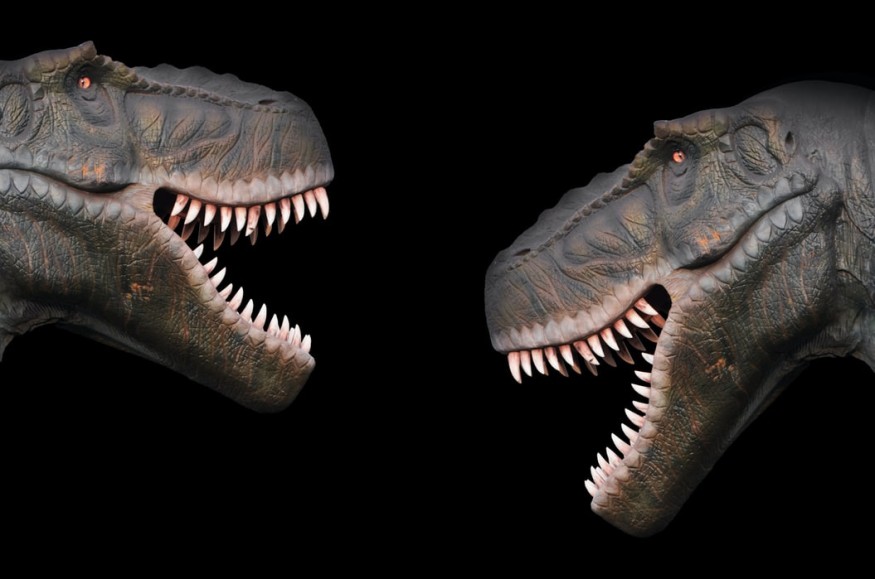The tyrant lizard king was not made for speed, contrary to common belief. According to a comprehensive new computer model, the mighty Tyrannosaurus rex could only brisk walk.
Paleontologists have long argued over what a T. rex's maximum speed was. Previously, experts estimated the largest lizard's top speed between 11 and 33 miles per hour (17.7 kilometers to 53.1 kilometers per hour).

But in reality, its chosen walking speed was just under 3 mph (5 km/h), which was about half the speed predicted earlier. According to the British Heart Foundation, that's about the average human walking speed.
That means that in a hypothetical competition between a human and the legendary dinosaur, a T. rex might outrun the world's fastest human, who clocks in at about 27 miles per hour.
Paleontologist William Sellers of the University of Manchester and his colleagues have crunched the numbers again, using much more detailed data.
According to their findings published this week in the journal PeerJ, the lower end of the range is more reliable. The study, titled "Investigating the Running Abilities of Tyrannosaurus Rex Using Stress-Constrained Multibody Dynamic Analysis," claimed that T. rex would possibly only reach about 12 miles per hour. Its bones would have cracked if it had moved any quicker.
Scientists in the Netherlands also supported the study by creating a separate, new approach to estimate T. Rex's chosen walking speed based on examining a preserved specimen known as Trix. Their research is titled "Natural Frequency Method: Estimating the Preferred Walking Speed of Tyrannosaurus Rex Based on Tail Natural Frequency."
T. Rex Runs Slowly And Steadily
Paleontologists point to specific parts of the T. rex skeleton and claim that they showed the dinosaur was either fast or sluggish. When experts compared the limbs of T. rex to ostrich limbs, it seemed that the 40-foot-long dinosaur might have been quick.
T. rex's massive tail played an important role in its locomotion, according to Van Bijlert and his co-authors in an article published in the Royal Open Society Science journal on dinosaur movement.
They looked at how the animal could achieve a natural frequency of movement, taking into account not only leg muscles as in previous studies, but also tail movement to save energy.
"The tail would sway up and down with each step (like a giraffe's neck). If the step rhythm and tail natural frequency were matched, the tail would resonate, maximizing energy storage," Van Bijlert said on Twitter.
Animals prefer walking speeds that minimize energy cost for a given distance. One important strategy by which they achieve this is resonance: by moving a body part at the correct rhythm (its natural frequency), you get the "biggest movements" with the least effort. pic.twitter.com/ARM2nbimrT
— Pasha van Bijlert (@PashavanBijlert) April 21, 2021
However, it's too early to conclude that a person might have outrun a T. rex. The researchers said they were still studying the terrifying predator's walking speed and researching its top speeds.
ALSO READ : T. Rex Fossils Reveal It Was A Smart Dinosaur
It's also unlikely to be put to the test because the species died out more than 60 million years before humans arrived on the planet.
However, with more complex biomechanical models, scientists will get a lot closer to finding a response.
"You need to put all parts together to get a full picture. Just looking at morphology alone won't get you there," says John Hutchinson, an evolutionary biomechanics expert at the Royal Veterinary College in London who was not involved in the studies.
Bone stress was one of the new variables used in this model. When running, a bone can only withstand so much pressure before shattering.
Sellers and his team used the total body weight of a T. rex-roughly seven tons-along with the mechanical properties of bone to create their new model.
Hutchinson told National Geographic that this is a somewhat different strategy than in the past.
"This study uses the assumption that at maximum speed, the muscles weren't the limiting factor," he says. "At the previously proposed top speed, T. rex would have shattered foot bones, according to this model."
Sellers said T. rex was not one of the most "athletic" dinosaurs on the Cretaceous landscape, which comes as no surprise to most paleontologists.
Stephen Brusatte, a paleontologist at the University of Edinburgh who was not involved in the research, underscored that the movie picture of T. rex is incorrect.
"Paleontologists have known this for over a decade, and this latest research solidifies it by presenting the most advanced computer simulation studies to date."
Even so, Hutchinson observes, people take the demotion of a "celebrity dinosaur" like T. rex very seriously. "It has to be fast or it won't be cool," she says. People are emotionally attached to it."
Brusatte agrees and believes that this research would cast even more doubt on dinosaur fans' favorite movie scenes.
He claims that a T. rex might not have chased down the Jeep in Jurassic Park if it was traveling at highway speeds. "Perhaps in first gear, but even that is a major if."
RELATED ARTICLE : Baby Stegosaur Footprint From 100 Million Years Ago Discovered in China
Check out more news and information on Paleontology on Science Times.
© 2025 ScienceTimes.com All rights reserved. Do not reproduce without permission. The window to the world of Science Times.












